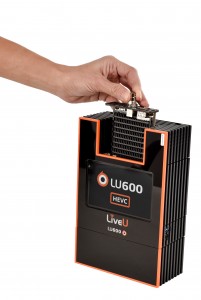SVG Europe Sit-Down: LiveU’s Ronen Artman discusses live streaming evolution and sports highlights
LiveU is helping to drive the live video revolution by providing live streaming for TV, mobile, online and social media. Using patented bonding and video transport technology, the company’s portfolio provides high-quality video feeds with a consistent bandwidth from anywhere in the world. Combined with robust cloud-based live video management and distribution software, the technology allows broadcasters of all sizes to acquire and share live video reliably on any viewing platform. As the technology improves, so does the number of solutions on offer. And that’s where we started our sit-down with Ronen Artman, vice president of marketing…
Technology within your product range is moving fast. What is your latest offering – and what are the benefits?
Wireless cellular-based transmission has become mainstream technology for broadcasters worldwide, replacing traditional distribution solutions, such as satellite and microwave trucks, with compact mobile units for live video transmission on the move. Not only broadcasters but also the online media market where we are now experiencing rapidly increasing sales of our direct-to-web/social media technology LiveU Solo. With increased reliability and reduced delay, portable transmission solutions enable broadcasters to capture high-quality video while being mobile, responsive and shooting from different locations.
LiveU’s most recent product release is the flagship LU600, launched at IBC 2016. The LU600 delivers the highest video quality and bitrate in the market, and is set to offer the fastest file transfer, lowest delay and 100Mbps high-speed bonded Internet connection. Tailored to the needs of mobile journalists, the LU600 offers a new streamlined user interface, with a 5.0-inch capacitive touchscreen.
The new LU600 is field upgradable to H.265 HEVC and we announced during NAB 2017 the launch of our HEVC Pro Card for the unit. Integrating the LU600 with the new 4K HEVC/H.265 hardware-based encoder allows professional broadcasters and content creators to benefit from new levels of video performance with extreme bandwidth efficiency. We’re adopting the HEVC standard across our entire product portfolio from our smallest uplink units to hybrid truck solutions, delivering the highest compression and lowest power consumption.
Drone operators are using your equipment. This will be of interest to sports broadcasters – so what are the challenges and the answers?
Drone use is in its early stages and there are still several challenges, including safety issues around operating drones in crowded areas and legal constraints, per country; and by venue. Some stadiums are not necessarily fitted for drone operations and some are located near airports which have restrictions on where drones can fly. Then there’s the question of battery life – drones are unable to fly for a long time (maybe only for around 15 minutes), which is an issue when covering live sport, such as tennis matches. And finally, the required infrastructure – such as pilot, navigator and so on.
In terms of answers, the safety and legal issues are likely to evolve as the technology evolves and drones’ battery life is sure to improve with time.
Live streaming is likely to be at the forefront of the 2018 Winter Olympics. Any plans you can discuss about those events?
LiveU’s technology has been used extensively to bring the Olympics to viewers worldwide. For the 2016 Rio Olympics over 300 LiveU IP-bonding units were deployed by more than 80 international broadcasters to cover the Games with over 5800 hours of video transmitted. As with the 2012 London Olympics, the portability of our technology allows broadcasters to really flesh out their coverage of the Games, creating more intricate, involving and exciting stories.
We anticipate very strong demand for our technology in order to cover the next Winter Olympics, though at this stage we don’t have any details.
How do you handle VR streaming?
We’ve been carrying out tests with specific cameras and our units and we already have a few early use cases with VR. Our priority is to support the most common VR cameras.
What are most common demands from users of your systems as far as ease of use, distribution of signals etc?
Signal robustness, even in challenging circumstances, is central to most people’s requirements. That, of course, affects which unit they choose and the number of SIM cards. There are other fundamental requirements, like a fast boot-up time – 30 seconds on the LU600, low power consumption – four-hour battery life, again on the LU600 and compact form factor.
You have a number of solutions on offer. What are the criteria for selecting one solution over another?
It really depends on the needs of the customer in terms of portability, performance etc. such as a global broadcaster covering an international sports competition or a media production house or freelancer covering a local event. Our portfolio includes our top-performing professional portable unit for live sports coverage, the LU600 with the HEVC Pro Card, the ultra-small LU200 unit for daily newsgathering and online broadcasts, the LU-Smart mobile app for reporting on the fly, and the LiveU Solo plug-and-play live streaming solution for online media.
It also depends on the environment, for example, LiveU’s Xtender transmission device – external antenna – can be used in crowded stadiums for extra resiliency.
Available bandwidth is another key factor, especially in remote areas. LiveU’s hybrid cellular and satellite systems are the best solutions in such scenarios, enabling broadcasters to enjoy the benefits of both satellite and cellular networks, and optimising all the available bandwidth to deliver broadcast-quality video. Field teams can choose least-cost bonding methods, for example, they can use cellular in areas with good reception or satellite – for example, Ka-Sat – in areas of poor cellular coverage, or combined, when stationary, and then seamlessly switch to the cellular networks provided by the remote transmission device while on the move.
Can you tell us about LiveU Central?
All LiveU’s solutions are integrated with LiveU Central, our unified management platform for easy preview and remote control. It allows full control and monitoring of the entire LiveU ecosystem and content via any browser-supported computer or tablet, from anywhere around the world as well as streamlined integration with leading social networks.


